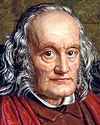
On 20 Jul 1804, Sir Richard Owen born, an English zoologist, anatomist and palaeontologist who could make remarkable reconstructions of many prehistoric animals and birds from even limited fossil evidence. Owen championed the idea of a new South Kensington building for the British Natural History Museum to house its burgeoning collections.
In his time, for his scientific work, he was so famous to the general public, that he was recognized in caricatures in popular magazines. For more of his accomplishments, read this article on Professor Owen from the magazine The Speakerpublished shortly after his death in 1892.
For a biography from a different author, giving some additional information, you can also read this chapter on Owen in the book, Biographies of Scientific Men, by A.B. Griffiths in 1912.

On 20 Jul 1804, Sir Richard Owen was born. By the mid-1850s, no scientist in the British Empire was more visible than Richard Owen.
Mentioned in the same breath as Isaac Newton and championed as Britain’s answer to France’s Georges Cuvier and Germany’s Alexander von Humboldt, Owen was, as the Times declared in 1856, the most “distinguished man of science in the country.”
But, a century and a half later, Owen remains largely obscured by the shadow of the most famous Victorian naturalist of all, Charles Darwin. Publicly marginalized by his contemporaries for his critique of natural selection, Owen suffered personal attacks that undermined his credibility long after his name faded from history.
Today's book pick is: , by , who resuscitates Owen’s reputation. Arguing that Owen should no longer be judged by the evolution dispute that figured in only a minor part of his work, Rupke stresses context, emphasizing the importance of places and practices in the production and reception of scientific knowledge. Dovetailing with the recent resurgence of interest in Owen’s life and work, Rupke’s book brings the forgotten naturalist back into the canon of the history of science and demonstrates how much biology existed with, and without, Darwin.
It is available from Amazon, typically about (As of earlier time of writing - subject to change.)
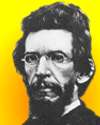 | Statistics are far from being the barren array of figures ingeniously and laboriously combined into columns and tables, which many persons are apt to suppose them. They constitute rather the ledger of a nation, in which, like the merchant in his books, the citizen can read, at one view, all of the results of a year or of a period of years, as compared with other periods, and deduce the profit or the loss which has been made, in morals, education, wealth or power. |
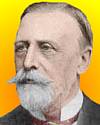 | Another source of fallacy is the vicious circle of illusions which consists on the one hand of believing what we see, and on the other in seeing what we believe. |
 | The invertebrated classes include the most numerous and diversified forms of the Animal Kingdom. At the very beginning of our inquiries into their vital powers and acts we are impressed with their important relations to the maintenance of life and organization on this planet, and their influence in purifying the sea and augmenting and enriching the land—relations of which the physiologist conversant only with the vertebrated animals must have remained ignorant. |
| Before you look at today's web page, see if you can answer some of these questions about the events that happened on this day. Some of the names are very familiar. Others will likely stump you. Tickle your curiosity with these questions, then check your answers on today's web page. | |
| Births | |
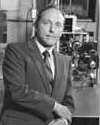 | Robert D. Maurer, born 20 Jul 1924, is an American research physicist, who with his colleagues, Dr. Donald B. Keck and Dr. Peter Schultz invented the fused silica optical waveguide. What is this used for, and what problem had they solved? |
 | Sir Richard Owen, born 20 Jul 1804, was an English anatomist and paleontologist who is remembered for his strong opposition to the views of Charles Darwin. He gave us many of the terms still used today in anatomy and evolutionary biology, including “homology.” He also created a word meaning “terrible lizard” (1842) that is well-known today. What is the word he coined for “terrible lizard”? |
| Deaths | |
 | An Italian inventor (1874-1937) invented the wireless telegraph in 1935 known today as radio. In 1894, he began experimenting on the “Hertzian Waves” (the radio waves Hertz first produced in his laboratory a few years earlier). Lacking support from the Italian Ministry of Posts and Telegraphs, he turned to the British Post Office. Encouraging demonstrations in London and on Salisbury Plain followed. In 1897, he obtained the world’s first patent for a system of wireless telegraphy. He opened the world’s first radio factory at Chelmsford, England in 1898. In 1900 he took out his famous patent No. 7777 for “tuned or syntonic telegraphy.” Can you name this inventor? |
| Events | |
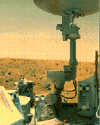 | On 20 Jul 1976, an American spacecraft, launched 20 Aug 1975, made its successful, first-ever landing on Mars at Chryse Planitia, and began transmitting pictures. Later, a robot arm that could scoop up samples of material and deposit them into on-board experiments, investigated the hint of life on Mars. Both weathered top soil and deeper soil samples were tested. What was the name of this spacecraft? |
 | On 20 Jul of a certain year, Apollo XI astronauts Neil Armstrong and Edwin “Buzz” Aldrin became the first men to walk on the moon, after their lunar module separated from the command module and landed on the lunar surface. Armstrong stepped on the lunar surface at 10:56 ET and proclaimed, “That's one small step for man, one giant leap for mankind.” Nearly 700 million people around the world were tuned in. What year did this event take place, and what is the name of the area where they landed? |
Fast answers for the previous newsletter for July 19: technique of radioimmunoassay (RIA) of peptide hormones • 1.65 miles (according to NOAA National Ocean Service) • nitrogen • Paris • Isambard Kingdom Brunel.
 If you enjoy this newsletter, the website, or wish to offer encouragement or ideas, please send feedback by using your mail reader Reply button.
If you enjoy this newsletter, the website, or wish to offer encouragement or ideas, please send feedback by using your mail reader Reply button. Your click on a Facebook, StumbleUpon, or other social button on the site webpages is also a welcome sign of appreciation. Thank you for using them.
© This newsletter is copyright 2020 by todayinsci.com. Please respect the Webmaster's wishes and do not put copies online of the Newsletter — or any Today in Science History webpage. (If you already have done so, please remove them. Thank you.) Offline use in education is encouraged such as a printout on a bulletin board, or projected for classroom viewing. Online, descriptive links to our pages are welcomed, as these will provide a reader with the most recent revisions, additions and/or corrections of a webpage. For any other copyright questions, please contact the Webmaster by using your mail reader Reply button.
--
If you do not want to receive any more newsletters, Unsubscribe
To update your preferences and to unsubscribe visit this link
Executive Real Estate Business Class
-
"It was like a man with wings. It wasn't like anything you'd see on TV or in a monster movie." ...
About the publisher
Search This Blog
Blog Archive
-
▼
2020
(1542)
-
▼
July
(200)
- PHOTOGRAPHY: The danger of documenting sharks
- Meet The Serial Killer Who Ate His Victims Because...
- The Roundup Top Ten from History News Network
- On This Day for July 31 - Lunar Roving Vehicle fir...
- Newsletter for Friday 31 July.
- Lockdowns killing more children than COVID + Docto...
- YOUR WEEKLY ESCAPE: Revisiting an iconic Nat Geo c...
- July 31: The Pilgrim Fathers Depart and the Battle...
- ANIMALS: The dog that got COVID-19
- On This Day for July 30 - Death of Otto von Bismar...
- Newsletter for Thursday 30 July.
- Frontline Docs 2nd Video Press Conf at SCOTUS We h...
- BREAKING NEWS: First U.S. dog to test positive for...
- July 30: First Defenestration of Prague, the 1st O...
- Demystified: Why Do Wolves Howl?
- The Champs Are Back on Forged in Fire Tonight
- SCIENCE: A rush to Mars during a rough patch at home
- Breaking News from History News Network
- On This Day for July 29 - National Aeronautics and...
- Newsletter for Wednesday 29 July.
- All Social Media Censor Frontline Docs COVID Video...
- July 29: Spanish Armada Scattered and Taft's Secre...
- TRAVEL: How to stay safe if you need to travel
- On This Day for July 28 - Beginning of World War I...
- Newsletter for Tuesday 28 July.
- Video Presentation from Washington Summit: America...
- July 28: Robespierre Guillotined, Austria-Hungary ...
- HISTORY: How the vice presidency became critical
- Enjoy Summer with Nat Geo Kids Magazine
- New This Week on History News Network
- On This Day for July 27 - Terrorist attack at Atla...
- Newsletter for Monday 27 July.
- COVID Propaganda & Tyrannical Edicts Affecting Men...
- July 27: Walter Raleigh Brings Tobacco, the Atlant...
- FAMILY: Can you transfer your ‘retro fun’ to your...
- The 10 greatest discoveries made by the British pu...
- On This Day for July 26 - Suez Canal seized, John ...
- Newsletter for Sunday 26 July.
- CDC says actual # of cases is up to 13X higher tha...
- July 26: 1st Muslim Civil War, Pizarro's Royal Cha...
- The Compass: Greece
- On This Day for July 25 - American advance into Ca...
- Newsletter for Saturday 25 July.
- VIRUS UPDATE: What does COVID-19 do to a child's b...
- July 25: The 1st Steam Locomotive, Mussolini Dismi...
- PHOTOGRAPHY: The photo that shocked a nation
- This Hardened Blob Of Nuclear Waste Could Kill You...
- On This Day for July 24 - Beginning of Mata Hari's...
- The Roundup Top Ten From History News Network
- Newsletter for Friday 24 July.
- Medical Journal: make the vaccine Mandatory! + Fre...
- YOUR WEEKLY ESCAPE: The man who claims to be Jesus...
- July 24: Cartier Lands in Canada, Mary Queen of Sc...
- ANIMALS: Let’s not forget this other catastrophe
- Demystified: Are Dogs Really Color-Blind?
- On This Day for July 23 - Egyptian monarchy topple...
- Newsletter for Thursday 23 July.
- listen to Dixie Brogdon Hopson tells how the hospi...
- July 23: Upper and Lower Canada United and the Bre...
- SCIENCE: The joy of vintage comforts
- A Puzzling Challenge on Forged in Fire Tonight
- Explore King Tut's tomb with National Geographic H...
- Breaking News from History News Network
- On This Day for July 22 - Deng Xiaoping reinstated...
- CDC Knows Masks and other methods don't work to st...
- Newsletter for Wednesday 22 July.
- July 22: First Congress of Vienna and Spoonerism
- TRAVEL: When tourism returns will it be better?
- Enjoy Summer with Nat Geo Kids Magazine
- On This Day for July 21 - Egyptians defeated in th...
- Newsletter for Tuesday 21 July.
- July 21: 1st Battle of Bull Run, the Trans-Siberia...
- HISTORY: John Lewis always stood for the same thing
- New This Week on History News Network
- On This Day for July 20 - First Moon landing, Sir ...
- Newsletter for Monday 20 July.
- What Scientific Study Shows 6 feet distance or "ma...
- July 20: On This Day in History
- FAMILY: Searching for patience
- Anne of Cleves: Henry VIII's most successful queen?
- On This Day for July 19 - U.S. women's suffrage mo...
- Newsletter for Sunday 19 July.
- Mask Truth Part 2, Data by Nations shows Hydroxych...
- July 19: 1st US Women's Rights Convention and V fo...
- The Compass: Colombia
- On This Day for July 18 - Publication of Mein Kamp...
- Newsletter for Saturday 18 July.
- Enough! Mask Truth, re-Creating you! the intended...
- CORONAVIRUS SPECIAL EDITION: What type of person d...
- July 18: Spanish Civil War Begins and 7 Years of K...
- PHOTOGRAPHY: Showing a nation losing its drinking ...
- How Julia Child Went From World War 2 Spy To Belov...
- Introducing Expedition: Learn! A New Way to Help K...
- The Roundup Top Ten for July 17, 2020
- On This Day for July 17 - Beginning of the Spanish...
- Newsletter for Friday 17 July.
- July 17: Execution of the Romanovs and a Stormy Bi...
- YOUR WEEKLY ESCAPE: An intimate look inside a mode...
- ANIMALS: The trouble with 'retired' chimps
- Man vs. 800-Pound Beast! Watch New Episode of Alon...
-
▼
July
(200)
-
Blogroll
-
About
HistoryFact










0 comments:
Post a Comment